General Information
Try a Great Daily Routine for Kids: 5 Easy-Peasy ADHD Routines to Try
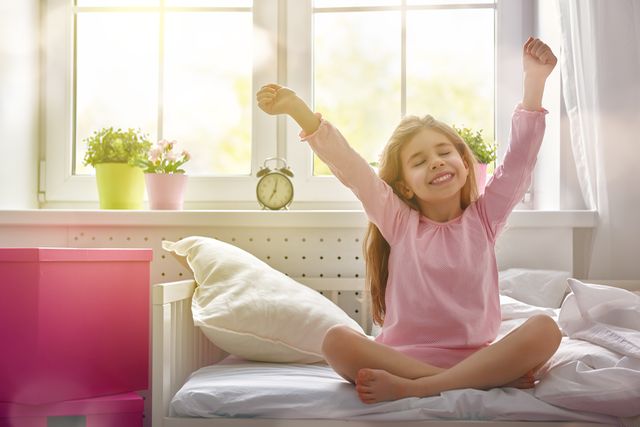
This month we’ve been exploring research (see our article The ADHD Routine: How Daily Routine for Kids with ADHD can be Beneficial) supporting a good ADHD routine.
The research suggests that a great daily routine for kids ease the symptoms of ADHD in children.
The Benefits of a Great Daily Routine for Kids
In summary, surveys show that certain types of daily routines ease the symptoms of “acting out” and arguing.
From this research, it is suggested that families put in place some routines. Such routines could be “household” routines, “homework” routines, and a routine for “discipline”.
As in any community and country, a family needs ‘laws’. Laws, or guidelines, or boundaries ensure everyone understands the expectations of the group. So, all members know how to use appropriate behaviour.
Also they know how to do necessary tasks to make this group (in this case, the family) a well-functioning system. Working this way, all members can be happy, while making contributions towards the well-being of the group (family).
Why an ADHD Routine?
Working with routines means essentially that an ADHD routine can be put in place. This is in order to help minimize the difficult challenges that ADHD can present in daily life.
Routines provide structure, predictability, and assist with implementing ‘rules and regulations’ in your family life.
How to Add Routine to My Child’s Life: 5 Easy-Peasy ADHD Routines to Try
PS: They’re also great for ASD, SPD, or ANY family looking for smoother days!
So now, we’ve partnered with parents, occupational therapists, and schoolteachers to offer parents our favorite, easy-peasy “ADHD routines” to add a little bit of reliability and continuity to your family’s daily life.
We’re categorizing each within the three types of scientifically-shown “best practices” – household, homework, and discipline.
Helping Our Kids With ADHD: Routines for the Household
A Household Routine is one that requires your child to accomplish a list of specific tasks that help the smooth operation of the household. Some tasks on your Household Routine could include:
- A kids morning routing chart for getting ready for school
- Cleaning up after dinner on weeknights
- Putting away toys after playtime
- Bringing laundry baskets out on laundry day
- Feeding and giving water to pets in the morning and evening
- Having a specified time frame for screen time on weekdays versus weekends
And for fun: include the parents’ routines when your child is older. They are often surprised to see what parents actually do to have the household run smoothly!
1. Kids’ Morning Routine Chart
A child is never too young to start using a kids morning routine chart! We recommend introducing the concept as early as potty-training time.
Choose 3-5 simple tasks that you expect your child would do every morning.
Create a visual aid that shows each step of the morning routine. Also, create a way for your child to interact with the visual aid to show that each step is complete.
There are wonderful, crafty resources on Pinterest to help in that department!
Explain that every day the morning routine must be complete. Then, offer some small reward for completing the routine in a reasonable amount of time without argument.
For example, mum Leena allows her son Harrison to watch one TV program before school if he’s completed the routine before 7:00 am. (It also allows her 20 minutes to complete her own morning routine alone!)
She does note to us that she had to add an additional stipulation: Harrison must turn off the TV when time is up without a fight, else he loses after-school TV privileges.
This same daily routine for kids for the morning can be evolved to grow with your child. Here are some kids’ morning routine suggestions at various ages:
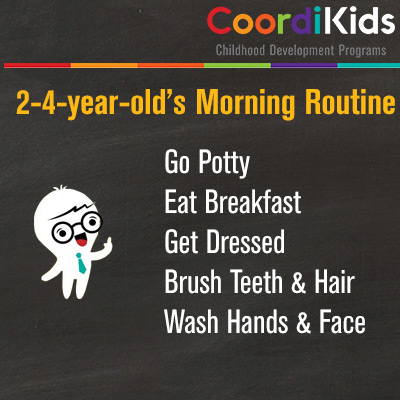
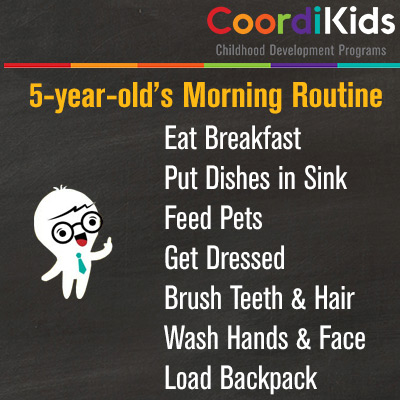
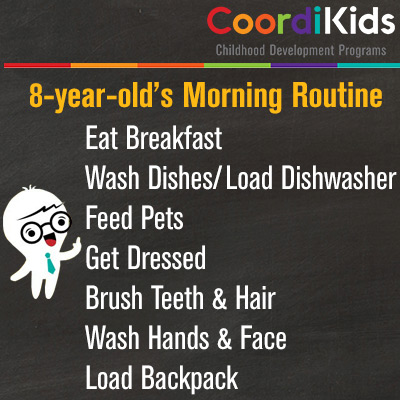
Bonus Morning Routine Tips:
- Set the alarm 15 minutes earlier to allow time for a cuddle, a story, prayers and to discuss the events of the day. For e.g.
- you have soccer after school, or
- you have music lessons, I’ll pick you up after at Gate 4, or
- it is Andy’s birthday, is his present in your bag?
- For those kiddies with poor planning, try these ideas. Put clothes out and use sticky notes on the school bag for reminders of sports shoes, extra books or musical instruments.
- If you leave the house with your kids, make sure your bag is packed. Make sure your own personal items are organized before you go to bed at night! It will make mornings easier.
2. Kids’ Bedtime Routine Chart
Use the same principle at bedtime to “bookend” your day with a routine. Choose 3-5 simple tasks that you expect your child would do every evening.
Explain that every evening the bedtime routine must be completed. Once the bedtime routine is completed, mum or dad will snuggle in bed for bedtime stories and hugs.
In Martha’s household, for extra reward, her twin girls earn a coin for their piggy banks when they complete the bedtime routines.
Various treats cost various amounts of coins, depending on what the girls are motivated by at the time.
For example, ice cream costs 5 coins, a visit to the animal park is 5 coins, a Happy Meal costs 10 coins, etc.
This same bedtime routine can be evolved to grow with your child. Here are some bedtime routine suggestions at various ages:
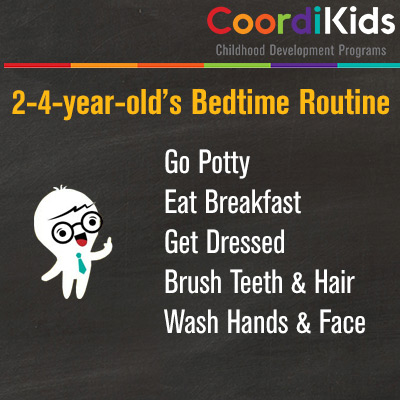
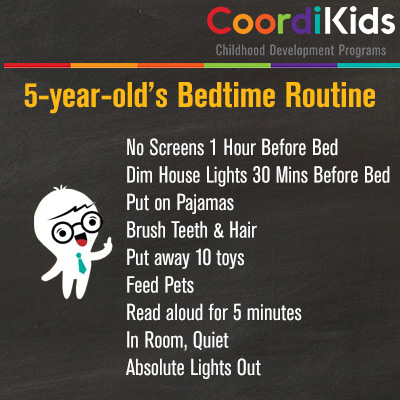
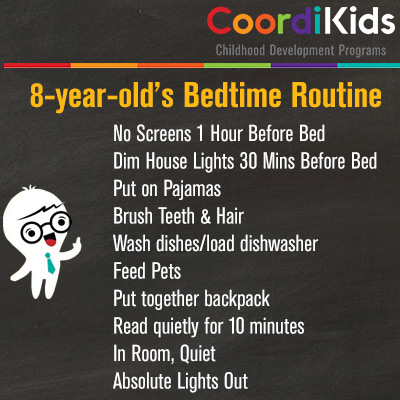
Bonus Bedtime Tips:
Dim the Lights, Lower the Volumes, and Turn Off the Screens.
Reducing sensory stimulation, like light and noise, around the house is helpful.
Doing this an hour before bedtime phases children from energetic daytime activities to relaxing nighttime activities. Then, it phases them into falling asleep.
Do 15 Minutes of Yoga.
Research supports that 8-13-year-old boys with ADHD benefitted from doing yoga as part of their bedtime routine.
Doing yoga even just once a week meant these boys were better at staying asleep and were less hyperactive in general. It’ll make YOU feel better too!
Give Your Child A 10 Minute Massage.
One of our favorite calming tips for sleeping! “Our bedtime routine includes a massage to give him appropriate sensory input,” explains mother Melissa.
Try Story Massage – a kit for parents looking for specific massage instructions and bedtime stories that incorporate massage. Relaxing sensory input like this will help with falling asleep more quickly.
Check in With Your Child About Possible Underlying Anxieties.
Talk about your child’s day. If she prefers, create a reflections jar where your child writes down her thoughts.
For example, write down “Things That Made Me Happy Today”, “Things That Made Me Scared Today” etc. and put them in the jar. This is to get them out of her head before bedtime.
Transition from lights out to sleep with light audio.
Try white noise, music for sleeping, nature sounds, Rhythmic Entrainment Intervention CDs, or the Dream Pad. Some kids enjoy listening to varying nature sounds and letting their imagination wander while falling asleep.
Alternatively, Rhythmic Entrainment Intervention (REI) music for sleeping CDs are based on relaxation research for staying asleep. Lastly, the Dream Pad is a pillow with an integrated audio and vibration system that some kids love.
Let us know which works best for your child for falling asleep and staying asleep.
Use a Weighted Blanket.
We often recommend weighted blankets, especially for a child who has problems with the sensation of touch.
For some parents, these can be a quick and surprisingly effective aid to falling asleep and staying asleep. Check with your occupational therapist regarding the ideal weight related to your child’s weight and age.
3. Helping Our Kids With ADHD: Routines for Homework
A Homework Routine includes any set of guidelines for your child or student to complete homework.
As with the simple household routines, start early and start simple. Even a 5-minute letter-drawing session before dinner can get your 4-year-old in the mindset of everyday homework time with mum or dad.
Those habits become an everyday lifestyle for grade-schoolers, which in turn become critical for high schoolers.
Making the routine simple and required every day is a great way to create good study habits before academics become even more challenging in higher education.
It is generally recommended to spend 10 minutes on homework per grade level.
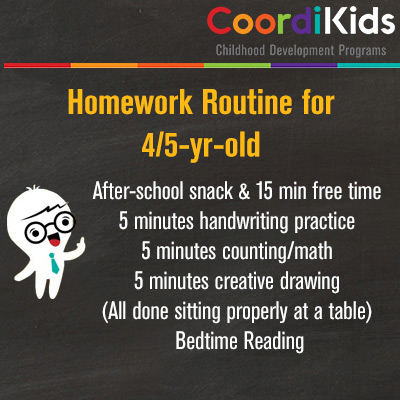
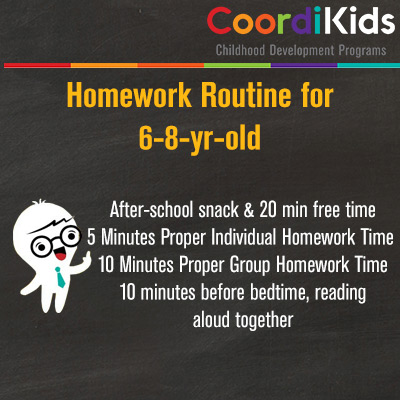
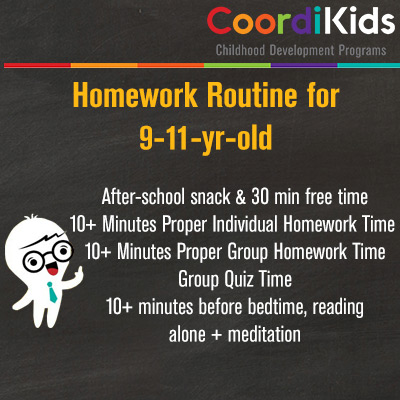
Some examples of Homework Routine habits include:
- A thirty-minute break immediately upon getting home, then a designated amount of homework time
- Group homework time on schooldays, including parents being available for help during a certain time frame
- Specifying 2-3 acceptable locations to homework in a distraction-free environment. Research shows that doing homework in the same place and time every single day is less effective.
- Use an alarm or a chore chart to remind children to get started on their homework time. However, you decide on the reminder, stick to it. This means no nagging 3-4 times. If you’ve reminded them once after the alarm has gone off and they still haven’t started, then they must face the consequences. Consequences should be predictable and non-debatable and enforced every time. This is because if you slip once, any normal and healthy kid will test you over and over again!
4. Helping Our Kids With ADHD: Routines for Discipline with The How Do You Feel Chart
A Discipline Routine simply means having some sort of standard discipline in place within your household. Discipline can range from taking away screen time to being “grounded” or having “time outs”.
“Time outs” are time periods in which a child must sit quietly in a secluded space for a few minutes before returning to the family or activity.
Children with ADHD benefit from taking a small time out or a “pit stop” when their emotions start building.
Create language your family can use to identify and ask for a pit stop before getting to a point where discipline is needed.
That’s why we felt it necessary to develop our own tool for parents and teachers to use when discussing emotions and self-regulation with children. The How Do You Feel? Chart is a visual aid developed by pediatric occupational therapists.
It is a Chart that categorizes 5 different emotional states. Using our cute friend Codi, the How Do You Feel? Chart describes each emotional state.
It also offers tips for helping children transition from one end of the emotional spectrum to a more neutral, calm and happy state. The chart is a very helpful tool in any daily routine for kids.
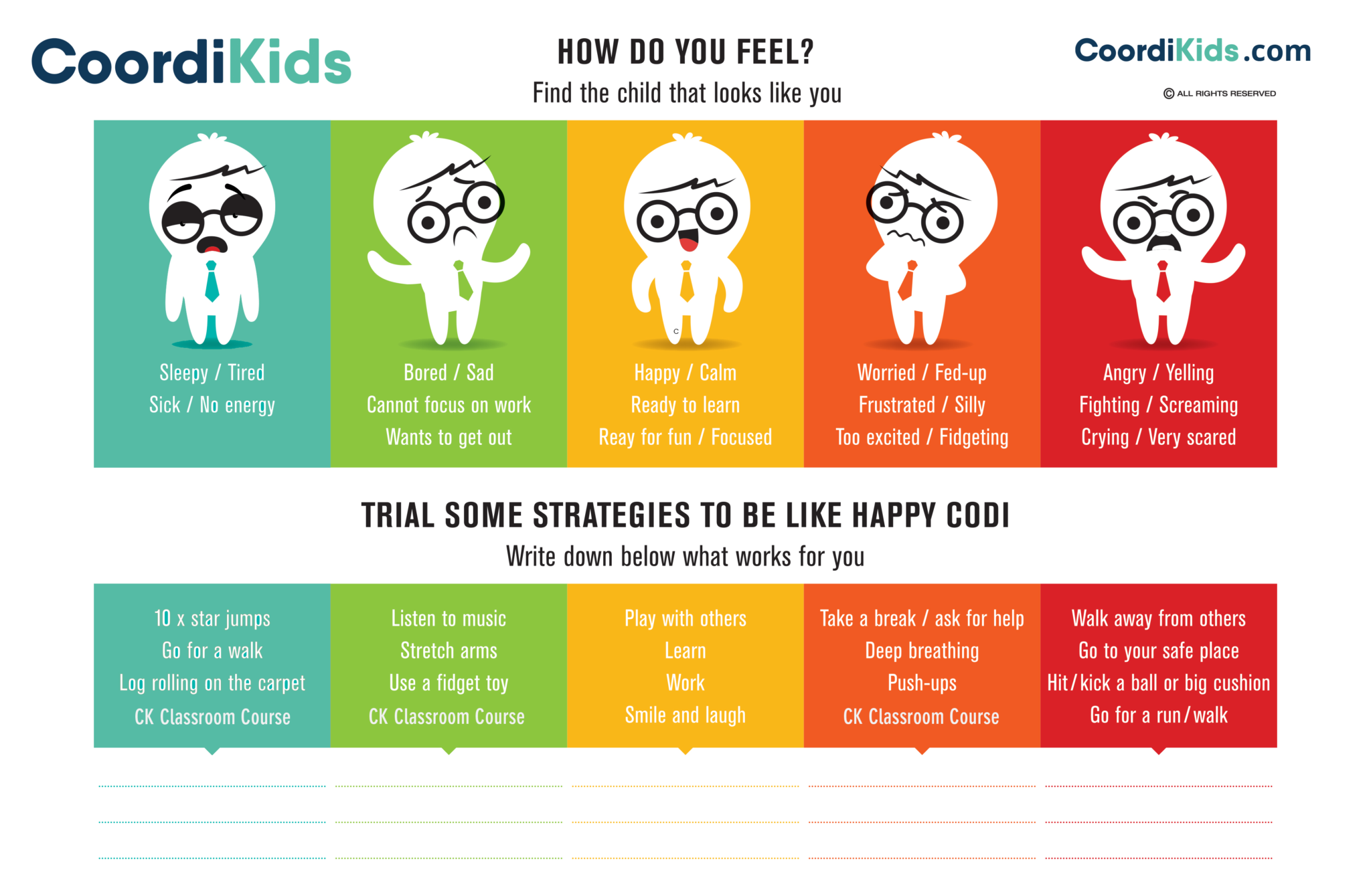
Right-click on the image and save as: to download the How Do You Feel? chart to use in your Discipline Routine to help guide your child’s emotional regulation.
5. Helping Our Kids With ADHD: Routines for Physical Activity with CoordiKids at Home Therapeutic Exercises
Studies show that routines, physical activity, and mid-brain stimulation reduce the negative symptoms of ADHD, amongst many others.
CoordiKids has a wonderful online childhood development programs for helping with the daily routine for kids.